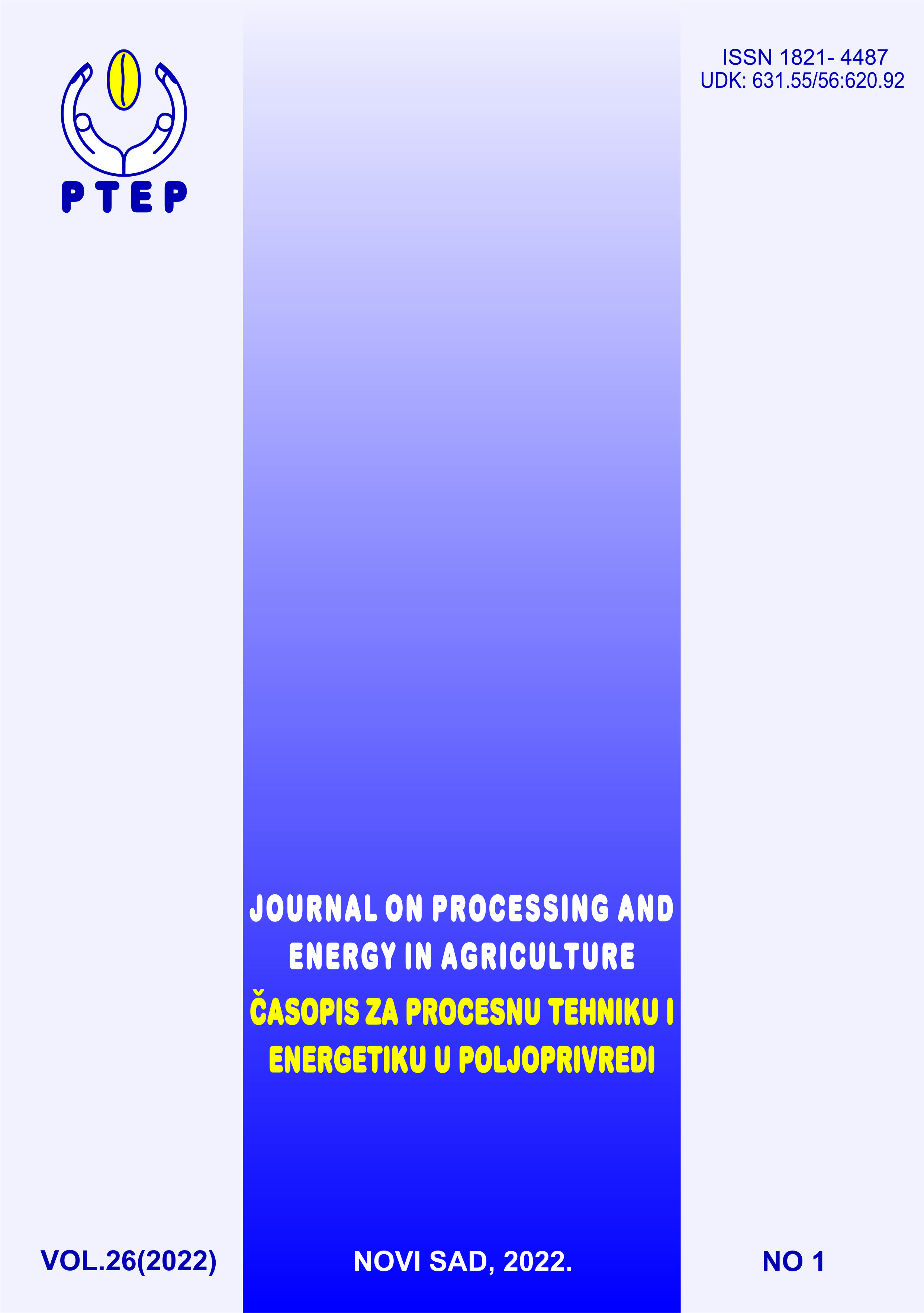Bacillus velezensis - BIOCONTROL ACTIVITY OF MICROBIAL BIOMASS AND EXTRACELLULAR COMPOUNDS AGAINST Xanthomonas spp.
Abstract
Bacillus velezensis is a novel biocontrol species exhibiting several mechanisms in biological control of plant pathogens, including antibiosis, production of other types of antimicrobial compounds, such as volatile organic compounds, direct competition for nutrients and growth space, and induction of plant immunity towards pathogens. The aim of this study was to assess the potential of Bacillus velezensis IP22, grown on the optimized medium with glycerol as carbon source, for in vitro suppression of phytopathogenic Xanthomonas strains - Xanthomonas campestris and Xanthomonas euvesicatoria. Different potential biocontrol agents were investigated: the overall cultivation broth, containing biomass of Bacillus velezensis IP22 and produced extracellular metabolites, and biomass-free supernatant obtained by centrifugation of the cultivation broth (10000 rpm, 10 min), which contained only the produced extracellular compounds. Furthermore, supernatant samples were subjected to heat treatment to assess whether there were thermosensitive extracellular compounds present in the supernatant. Vacuum evaporation was performed to concentrate supernatant samples in order to compare the effect of higher concentration of extracellular compounds to pathogens’ growth. The results have indicated average inhibition zone diameters of 66.00 mm for the cultivation broth samples, 25.67 mm for the supernatant samples, 10.00 mm for the heat treated supernatant samples and 43.50 mm for the concentrated supernatant samples. Further research should include optimization of the production processes aimed at maximization of Bacillus velezensis IP22 biomass growth and/or biosynthesis of the antimicrobial metabolites, as well as their precise identification and characterization to better understand the mechanism(s) of biocontrol activity against phytopathogenic Xanthomonas spp.
References
Alenezi, F.N., Slama, H.B., Bouket, A.C., Cherif-Silini, H., Silini, A., Luptakova, L., Nowakowska, J.A., Oszako, T., Belbahri, L. (2021). Bacillus velezensis: a treasure house of bioactive compounds of medicinal, biocontrol and environmental importance. Forests, 12, 1714.
Baharudin, M.M.A., Ngalimat, M.S., Shariff, F.M., Yusof, Z.N.B., Karim, M., Baharum,S.N., Sabri, S. (2021). Antimicrobial activities of Bacillus velezensis strains isolated from stingless bee products against methicillin-resistant Staphylococcus aureus. PLoS ONE, 16, e0251514.
Bihn, E.A., Reiners, S. (2018). Good agricultural practices and good manufacturing practices for vegetable production. In: Handbook of Vegetables and Vegetable Processing, 2nd edition, Siddiq, M., Uebersax, M.A. (Eds.). John Wiley & Sons, Hoboken, New Jersey, USA.
Chen, N.W.G., Serres-Giardi, L., Ruh, M., Briand, M., Bonneau, S., Darrasse, A., Barbe, V., Gagnevin, L., Koebnik, R., Jacques, M.-A. (2018). Horizontal gene transfer plays a major role in the pathological convergence of Xanthomonas lineages on common bean. BMC Genomics, 19, 606.
Chen, Z., Zhao, L., Chen, W., Dong, Y., Yang, C., Li, C., Xu, H., Gao, X., Chen, R., Li, L., Xu, Z. (2020). Isolation and evaluation of Bacillus velezensis ZW-10 as a potential biological control agent against Magnaporthe oryzae. Biotechnology & Biotechnological Equipment, 34, 714-724.
Fira, Đ., Dimkić, I., Berić, T., Lozo, J., Stanković, S. (2018). Biological control of plant pathogens by Bacillus species. Journal of Biotechnology, 285, 44-55.
Grahovac, J., Pajčin, I., Vlajkov, V., Rončević, Z., Dodić, J., Cvetković, D., Jokić, A. (2021). Xanthomonas campestris biocontrol agent: Selection, medium formulation and bioprocess kinetic analysis. Chemical Industry and Chemical Engineering Quarterly, 27, 131-142.
Jennings, A.A., Li, Z. (2020). Worldwide regulatory guidance values applied to direct contact surface soil pesticide contamination: Part I - carcinogenic pesticides. Air, Soil and Water Research, 10, 1-12.
Köhl, J., Kolnaar, R., Ravensberg, W.J. (2019). Mode of action of microbial biological control agents against plant diseases: relevance beyond efficacy. Frontiers in Plant Science, 10, 845.
Mácha, H., Marešová, H., Jŭríková, T., Švecová, M., Benada, O., Škríba, A., Baránek, M., Novotný, Č., Palyzová, A. (2021). Killing effect of Bacillus velezensis FZB42 on a Xanthomonas campestris pv. campestris (Xcc) strain newly isolated from cabbage Brassica oleracea convar. capitata (L.): a metabolomic study. Microorganisms, 9, 1410.
Pajčin, I., Vlajkov, V., Frohme, M., Grebinyk, S., Grahovac, M., Mojićević, M., Grahovac, J. (2020). Pepper bacterial spot control by Bacillus velezensis: bioprocess solution. Microorganisms, 8, 1463.
Payá Pérez, A., Rodríguez Eugenio, N. (2018). Status of local soil contamination in Europe: Revision of the indicator “Progress in the management Contaminated Sites in Europe”, EUR 29124 EN. Publications Office of the European Union, Luxembourg, Belgium.
Potnis, N., Timilsina, S., Strayer, A., Shantharaj, D., Barak, J.D., Paret, M.L., Vallad, G.E., Jones, J.B. (2015). Bacterial spot of tomato and pepper: diverse Xanthomonas species with a wide variety of virulence factors posing a worldwide challenge. Molecular Plant Pathology, 16, 907-920.
Raman, N.M., Easwaran, M., Kaul, R., Bharti, J., Motelb, K.F.A., Kaul, T. (2020). Antimicrobial resistance with special emphasis on pathogens in agriculture. In: Antimicrobial resistance, Mareș, M., Lim, S.H.E., Lai, K.-S., Cristina, R.-T. (Eds.). IntechOpen Limited, London, UK.
Shu, X., Wang, Y., Zhou, Q., Li, M., Hu, H., Ma, Y., Chen, X., Ni, J., Zhao, W., Huang, S., Wu, L. (2018). Biological degradation of aflatoxin b1 by cell-free extracts of Bacillus velezensis DY3108 with broad pH stability and excellent thermostability. Toxins, 10, 330.
Sundin, G.W., Wang, N. (2018). Antibiotic resistance in plant-pathogenic bacteria. Annual Review of Phytopathology, 56, 161-180.
Wang, S., Sun, L., Zhang, W., Chi, F., Hao, X., Bian J., Li, Y. (2020). Bacillus velezensis BM21, a potential and efficient biocontrol agent in control of corn stalk rot caused by Fusarium graminearum. Egyptian Journal of Biological Pest Control, 30, 9.
Ye, M., Tang, X., Yang, R., Zhang, H., Li, F., Tao, F., Li, F., Wang, Z. (2018). Characteristics and application of a novel species of Bacillus: Bacillus velezensis. ACS Chemical Biology, 13, 500-505.

